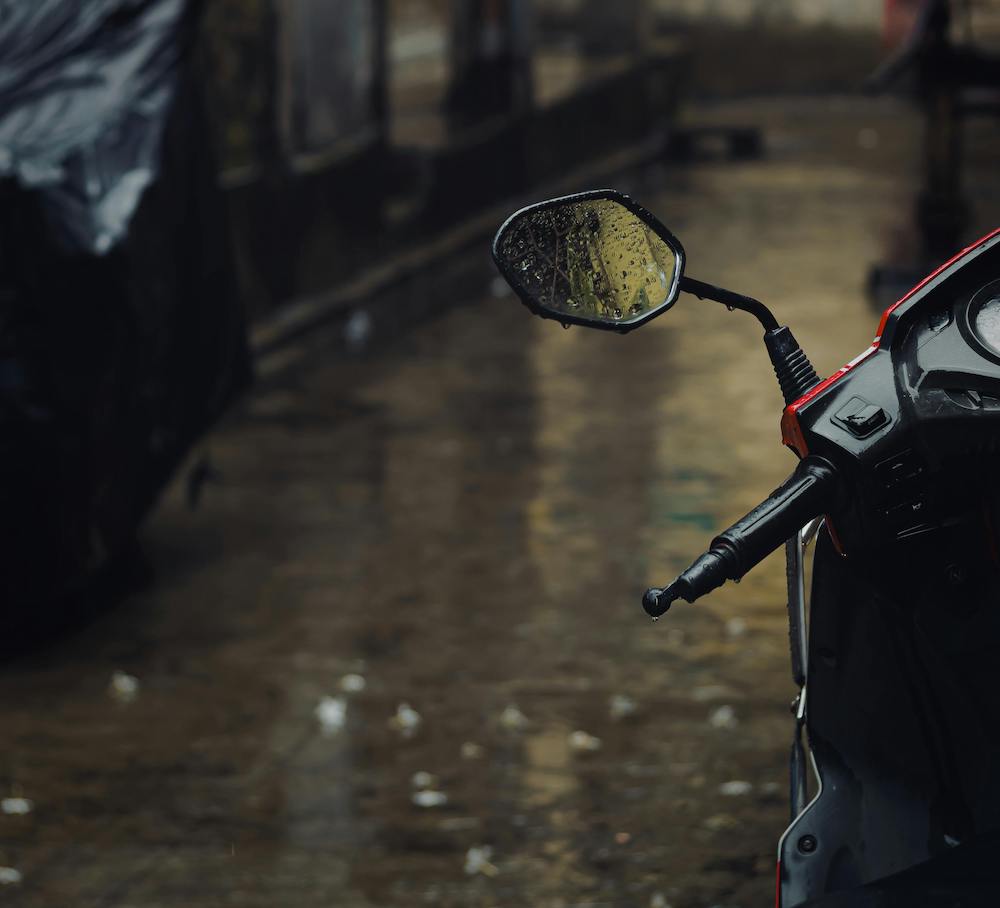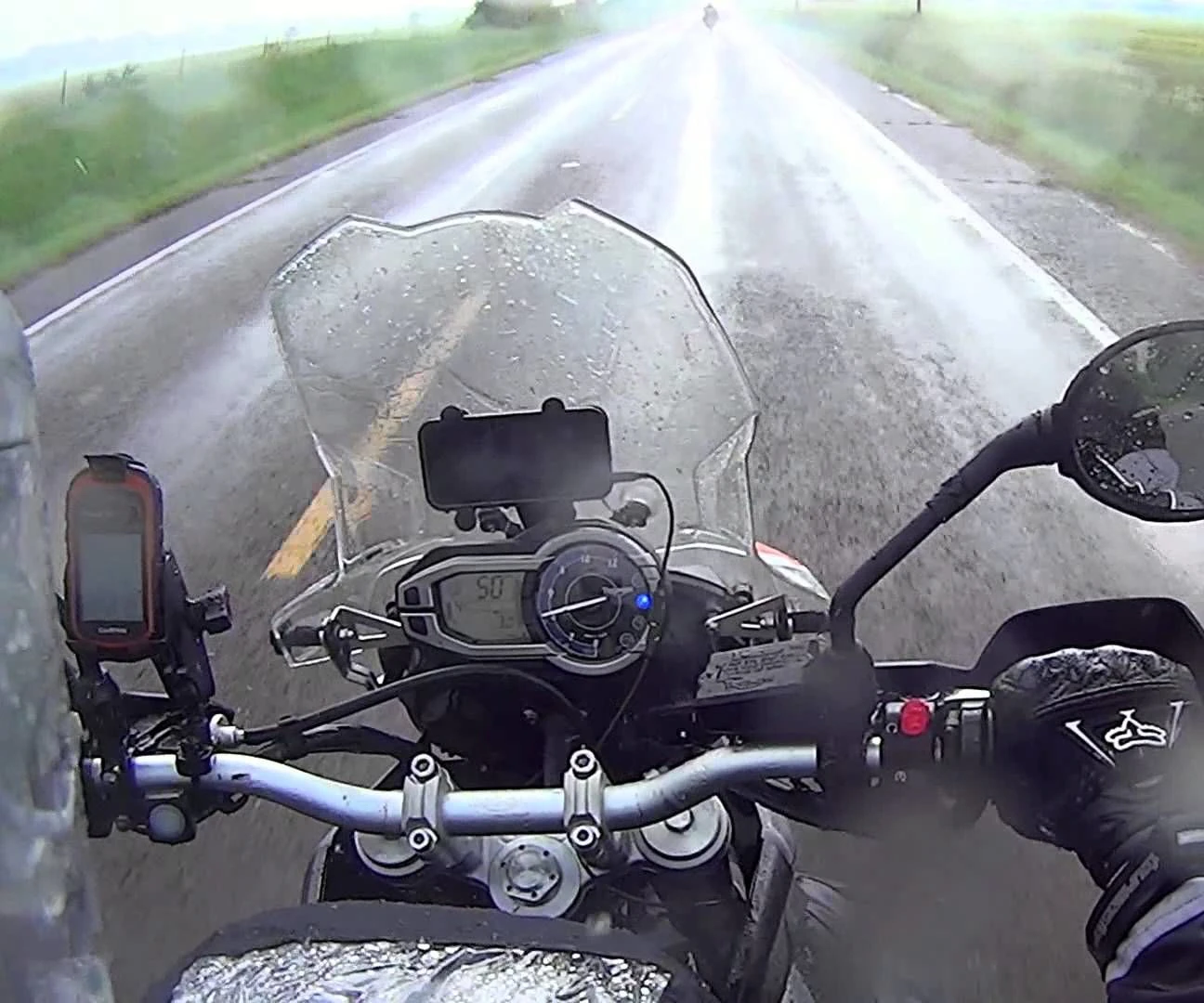back to the blog
How to Ride a Motorcycle in the Rain

Olivia C · January 20, 2025
For many riders, especially beginners, riding a motorcycle in the rain can feel daunting. Even experienced riders might think twice about heading out in wet conditions, but rain is an unavoidable part of motorcycling—especially in the UK. The good news? Embracing rainy rides not only boosts your confidence but also sharpens your riding skills. Here’s everything you need to know to stay safe and enjoy the ride in the rain.
Is it OK to Ride a Motorcycle in the Rain?
Yes, it is perfectly fine to ride a motorcycle in the rain, provided you take the right precautions. With the right gear, techniques, and mindset, riding in the rain can be (almost) as enjoyable as a sunny-day ride. That said, proper preparation and heightened awareness is essential if you want to ride comfortably and safely.
When Should You Not Ride a Motorcycle?
Although riding in the rain is manageable, there are situations where it’s best to avoid taking your bike out:
- Heavy storms: Thunderstorms or torrential downpours can hugely reduce visibility and make roads hazardous.
- Flooded roads: Riding through deep water risks damaging your motorcycle’s engine and losing control.
- Severe cold: Freezing rain can create icy conditions, making it extremely dangerous to ride. If you’re unsure, it’s always better to err on the side of caution and wait for better weather.

How to Prepare for Riding in the Rain
Do You Have the Right Gear for Wet Weather?
Gear is your first line of defence against the elements. Investing in high-quality waterproof and weatherproof gear ensures you stay dry, warm, and focused on the road. Here are the essentials:
- Waterproof clothing: A rainsuit or waterproof jacket and trousers are must-haves. Moisture-wicking base layers add extra comfort.
- Waterproof boots and gloves: Waterproof gloves and boots are crucial to keep your hands and feet warm and dry.
- High-Viz gear: Visibility decreases for everyone on the road when it rains, so invest in high-viz gear to make sure you’re seen.
- Helmet with anti-fog visor: Foggy visors reduce visibility. Opt for an anti-fog visor or use an anti-fog spray. Pinlock inserts are also a great solution to maintain a clear view.
Will My Motorbike Rust if I Ride in the Rain?
Riding in the rain won’t ruin your motorcycle as long as you maintain it properly. After wet rides, wash off any dirt or salt from the road and dry your bike thoroughly. Applying a waterproofing spray like Oxford Mint Rainseal can help prevent rust.
How Do Motorcyclists See in the Rain?
One of the biggest challenges riders face in the rain is being able to see clearly If you’re riding at higher speeds rain build up is less of an issue, since the wind does a good job of blowing water droplets away from your visor. But it's a bit trickier at low speeds.
Here’s how you can improve visibility:
- Helmet visor: As mentioned, use an anti-fog insert or spray. Keep your visor clean and use a water-repellent treatment like Rain-X to help water bead off.
- Helmet vents: Open them slightly to improve airflow and reduce fogging.
- Wiping techniques: A quick wipe with your glove can clear rain from your visor, but don’t take your eyes off the road!

Riding Techniques for Wet Conditions
Pick Your Lines Carefully
When the rain lightens up, look for the tyre tracks of other vehicles. These “dry lines” offer slightly better traction as the tyres displace surface water. However, be cautious of:
- Manhole covers
- Painted lines
- Cats’ eyes; All of these can be extremely slippery when wet.
These things aren’t disastrous or hidden death traps, just keep calm and try not to panic if you hit things like this. It’s just an extra precaution worth consideration.
Be Aware of Potentially Hazardous Road Surfaces
Wet roads can bring hidden issues:
- Loose debris: Light rain can lift dirt, fuel, and oil to the road’s surface, so just be wary of this.
- Puddles and standing water: Puddles could be hiding large potholes or debris, so avoid riding through them if you can.
- Oil spills: These appear as rainbow-like patches. Avoid riding over them because they can be very slippy and cause you to slide.
.jpeg)
Ride Smoothly
Rainy conditions demand smooth and controlled movements. Sudden braking or jerky accelerations can easily unsettle your motorcycle. Follow these tips:
- Acceleration: Apply throttle gently to avoid wheel spin.
- Braking: Use both brakes smoothly and progressively. Rely slightly more on the rear brake to improve stability.
- Cornering: Keep your bike more upright and reduce lean angles. Enter corners at lower speeds and avoid abrupt changes in direction.
Relax and Stay Calm
A common mistake when riding in the rain is tensing up. Stay relaxed and keep a firm but not stiff grip on the handlebars. This helps you react more naturally and keeps fatigue at bay. If you’re out for a long ride, plan for extra breaks to help with the mental effort of staying more focused.
More Tips for Wet-Weather Riding
- Warm up your tyres: Stop-and-go riding or light acceleration can generate heat and improve grip.
- Slow down: Wet roads reduce traction, so give yourself more time to react.
- Plan your route: Stick to main roads when possible, as they’re more likely to be well-maintained and free of debris.
- Increase following distance: Leave more space between you and the vehicle ahead to account for longer braking distances.
Embracing the Rain
Riding a motorcycle in the rain doesn’t have to be a miserable experience. With practice and the right approach, it can actually be a fun challenge. If you’re still building your confidence, start with shorter rides to get a feel for wet conditions. Over time, you’ll develop the skills and experience to handle rain like a pro.
So don’t let a bit of rain keep you off the road. Suit up, stay sharp, and enjoy the ride!


